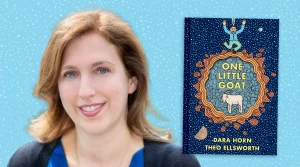There’s nothing quite like enjoying a seder with family and friends. But there are times when you must spend the holiday away from loved ones, whether you are studying abroad, backpacking through the Himalayas or serving in the military. Whether you find yourself at home or abroad this Pesach, I hope you will enjoy these stories.
I was fascinated to find several examples of how American soldiers have made do during the holiday. In “A Reminiscence from the Civil War,” we read from the memoirs of Joseph A. Joel “who enlisted from Cleveland, Ohio, in the Union cause.” Here’s his description of his Passover seder in the spring of 1862. “We obtained two kegs of cider, a lamb, several chickens and some eggs. Horseradish or parsley we could not obtain, but in lieu we found a weed, whose bitterness, I apprehend, exceeded anything our forefathers ‘enjoyed’… There, in the wild woods of West Virginia, away from home and friends, we consecrated and offered up to the ever-loving God of Israel our prayers and sacrifice.”
READ: FROM ALASKA TO ETHIOPIA: PASSOVER SEDERS FROM AROUND THE WORLD
Rabbi Mayer Abramowitz had the responsibility of conducting the first Passover seder in Occupied Germany in April 1945. The seder took place in the city of Kassel in a bunker that held 300 Jewish personnel and 100 Jewish survivors. Particularly poignant is how the rabbi describes a survivor recounting his ordeal. “He had us in tears as he recounted the afflictions he and his fellow survivors suffered under the Nazis. Then, he concluded expressing his happiness at being able to celebrate their first seder after five tortuous years. Finishing his remarks, he toasted the general, shook hands with him and then turned to embrace me with tears in his eyes.”
Now skip ahead to another century and another continent. Major Jonas Vogelhut of the 101st Airborne Division describes his “Seder Somewhere in Iraq.” “The service concluded with songs and Psalms like ‘The Lord is on my side, I have no fear.’ … Together our unit made this tent a house, this house a home, a piece of Judaism; and a piece of America.”
Thanks to the efforts of the JWB Chaplains Council, here’s what soldiers can expect to find in their “Solo Seder Kit”: a box of matzah, two cans of chicken matzah ball soup, two cans of tuna, a bottle of kosher grape juice, a Haggadah and a Passover pamphlet.
Chabad rabbis are known for organizing seders in locations, no matter how remote. If you think you might be spending some time in Thailand or Turkey, there’s room for you at a seder table. Rabbi Dror Moshe Shaul has welcomed several hundred Israelis to his Seder tent in Dharamsala, India, in the foothills of the Himalayas. At the same time, he also helped arrange observance of the holiday in an unorthodox location.
“Before the holiday, Rabbi Dror succeeded in sneaking some matzahs into the nearby monastery. The Israelis who come to study meditation are not allowed to leave the grounds until they complete the weeklong course. After the holiday, a number of youths approached Rabbi Dror to tell him that they were in the monastery at the time of the seder, and ate the matzahs. While outside they heard the singing of Echad Elokeinu ShehbaShamayim U’va’aretz (one is our God in the heavens and the earth.)
Years ago, Amy Varnhagen Hawkes found herself in Florence, Italy, in search of a seder. But what she found outside the historic synagogue shook the White Plains, N.Y., native – six soldiers in a wagon armed with “large and ominous machine guns” guarding the temple gates. Inside, the atmosphere was warm and welcoming and safe. But knowing that it took a half-dozen soldiers to protect them had an impact on Hawkes’ seder.
“That night was very different than any other night in my life. The 10 drops of wine that I lifted from my glass were not enough. As I dipped my finger into the glass for the 11th time I murmured, ‘Machine guns.’ My eleventh drop of wine is for the anger when one’s freedom to worship is challenged.”
Over in the Far East, Rabbi Yosef Jacobson’s seder in Kobe, Japan was his most memorable ever. During the seder, he related a classic Passover tale about the 18th-century spiritual master, Rabbi Levi Yitzchak of Barditchev. After the seder, a woman who had been weeping profusely approached Rabbi Jacobson.
“I grew up in an assimilated home,” the woman said. “I know nothing about Judaism. I work here in Japan for 20 years as a school teacher, and am involved in eastern mystical disciplines. The only thing I know of Judaism was that my grandmother told me that I have a special spiritual connection. ‘You are the 10th generation of Reb Levi Yitzchak of Barditchev.’ Who was Rabbi Levi Yitzchak of Barditchev? My grandmother never knew. She just knew that he was great, and insisted that I retain this piece of history. Thank you, Rabbi Jacobson for bringing me home.”
READ: CANADA’S FIRST MATZAH FACTORY
There wasn’t a fairy tale ending (at least not right away) when Naomi Tomsky was studying in Uruguay and in search of a seder. She looked high and low for a seder but could not find one. “I was lonely and sad … I hummed the tune to the four questions in the shower and reminded myself how lucky I was to be spending the term living in South America.” But when Tomsky returned to the United States, she resolved to make sure no one would find themselves in her predicament, by creating larger and larger annual seders welcoming anyone who needed a meal.
During one of those seders, it hit her “in the middle of an explanation of why we (briefly) open the door and put out an extra glass of wine, that I realized the strength with which Passover’s meaning had burrowed deep within me. Alone in a foreign country, I had longed for someone to open his or her house and share a drink with me. I now understood that my invitations to strangers on Twitter or to friends of friends of friends were my modern way of following ancient, biblical commands. After all, the Haggadah begins the Passover story by exhorting us, ‘Let all who are hungry come and eat.’”
Chag Kasher ve’Samayach.
Contact Mark Mietkiewicz via email here.






